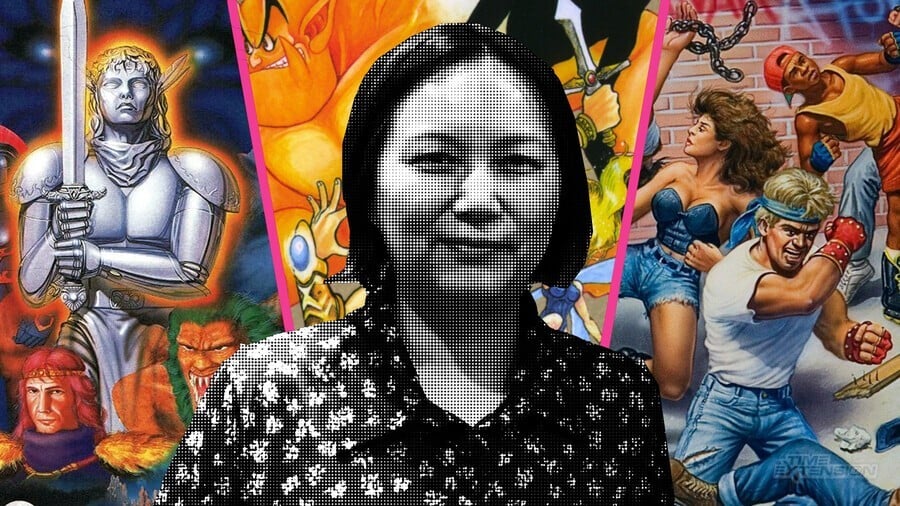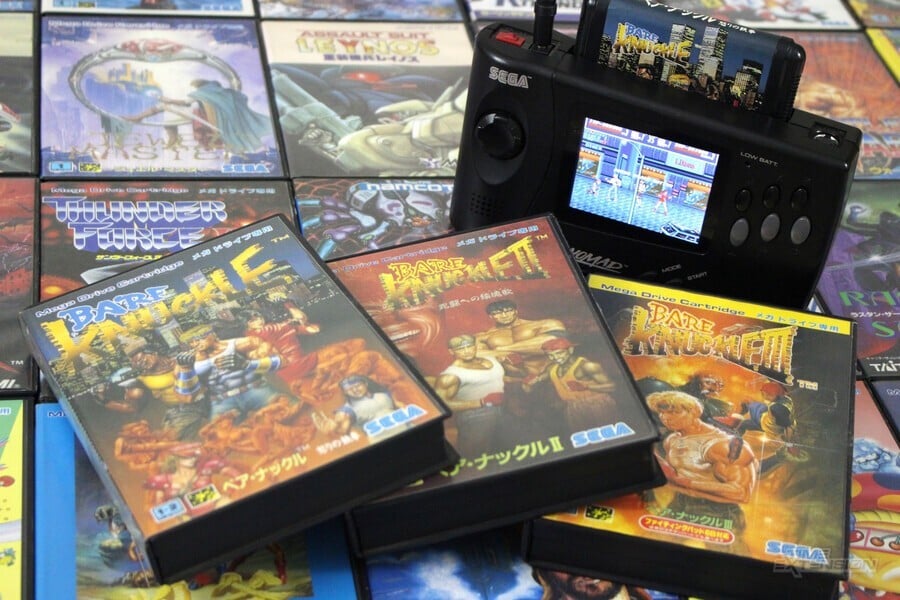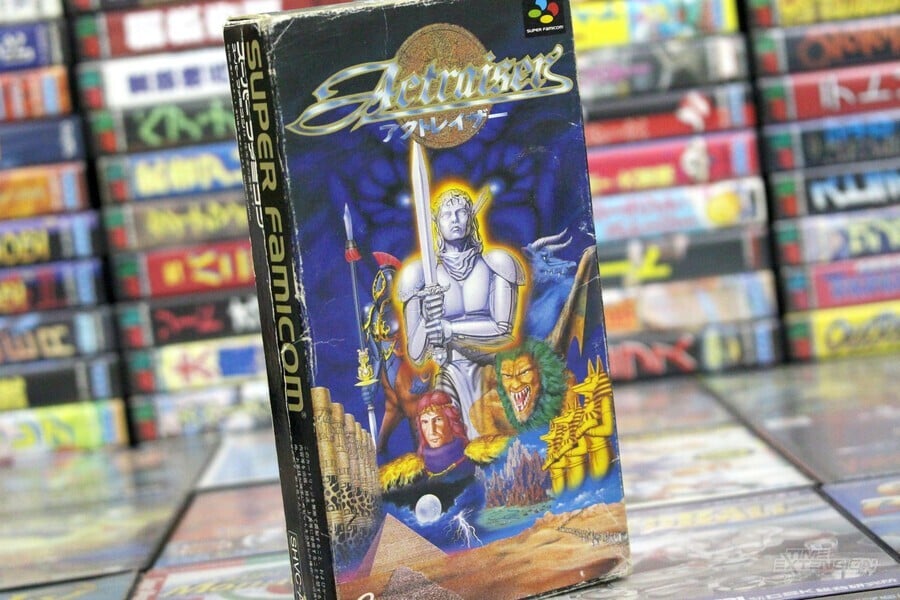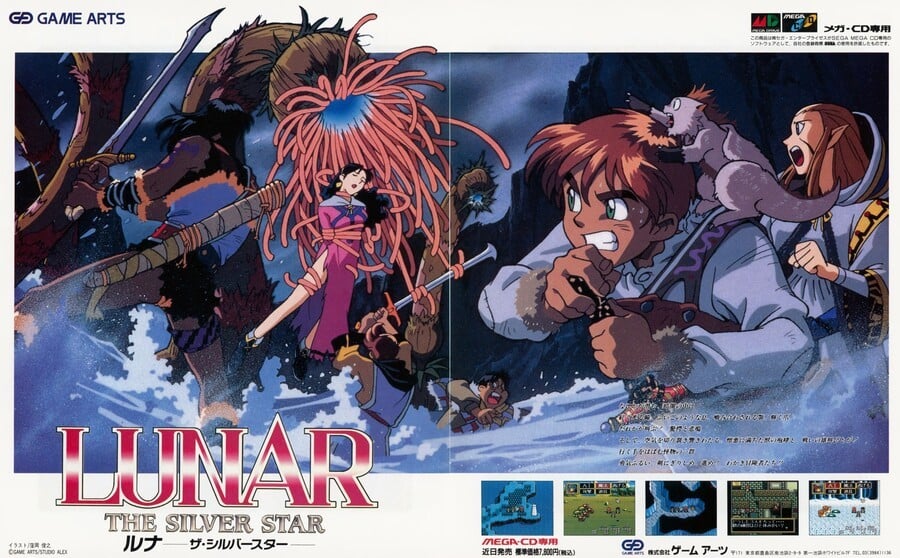
In the late '80s and early '90s, many western players would have been quite familiar with composer Yuzo Koshiro – after all, his name can be seen right on the title screens of games like Revenge of Shinobi and Streets of Rage. But did you know that he has a sister, and she's also involved in video games? Ayano Koshiro's name can be found in the credits of games like ActRaiser, Streets of Rage 2 and the excellent Master System version of Sonic the Hedgehog. Ayano may have a famous sibling, but she's an absolutely amazing designer and artist – and a major driving force behind many hits of the golden 16-Bit era.
In her early 20s, Ayano led the development of Streets of Rage 2, perhaps the best console beat 'em up of its time. She left her mark on both episodes of Quintet’s ActRaiser, while on the Mega-CD RPG Lunar: The Silver Star, she showed the young, newly-hired artists at Game Arts' Studio Alex how to draw and animate a proper pixel monster.
Then there is Story of Thor (known as Beyond Oasis in North America), in which she combined a Zelda-style action adventure with spectacular combat. Alongside this glittering career, Ayano has often worked together with her (now) husband Hitoshi Ariga, who has also had a hand in many a classic game and today works as a designer and mangaka, mainly for the Rockman / Mega Man and Pokémon series.
Needless to say, we were pretty excited to meet a creator with such a pedigree to her name. Sitting down with Ayano and her husband Hitoshi in a small restaurant near the office of the family-founded company Ancient, we have a long, relaxed talk over delicious food – and in the process, we get a glimpse of how games we consider absolute classics nowadays came to be.
Ayano Koshiro has left a deep mark in the gaming world and effortlessly joins the upper echelons of game developers in the golden '90s – and here's her story, in her own words.
Time Extension: You took your first steps into game development at the age of 16 – how did that come about?
Ayano Koshiro: I think I just started because I wanted to draw. I really liked the look of PC games at the time, and I just loved games. So part of me always wanted to draw in that style, that typical look of the home computer games of the time. And one thing I also always wanted to trace, or rather pixelate, was the Big Core, this iconic boss from Gradius. That's a beautifully designed boss, and I wanted to draw that myself. I owned a PC at the time, I think it was a PC-88, and it could do a full eight colours. And some of the graphics on that system were really beautiful and complex. I wanted to draw things like that.
Hitoshi Ariga: Wow, you really had a lot of money back then!

And then, what were the first practical steps you took?
Ayano Koshiro: I started directly on a PC. I don't think I ever worked with drawing paper. At that time, there was a game company called Nihon Falcom in Tachikawa, not so far from here. My big brother was already working there part-time. I often went there with him just for fun. And then I also did some drawing there. It's not that I necessarily wanted to work in this industry, I just came along because it interested me.
And did you go on to study design or something like that?
Ayano Koshiro: No, I taught myself all that, I never went to a design school or anything like that.
Hitoshi Ariga: At that time there were no schools for game design or anything.
Ayano Koshiro: I never went to a classical art school or anything like that, either. But my father was an artist. There also were a lot of magazines and books about games back then, and they often had artwork of the games. I cut them out and made scrapbooks out of them. Then I tried to draw it myself.
Many games from the '80s and '90s have a lot in common with the manga and anime that were popular at the time; did that influence you as well?
Ayano Koshiro: Yes, I read and collected a lot, too, of course. Space Battleship Yamato I liked very much. And Gundam. Or Six God Combination Godmars. Many anime and manga that somehow had a military background. Later, Neon Genesis Evangelion was also a very important thing, of course. I was a real anime otaku at that time. I bought two anime magazines every month. And many manga anthologies every week. Jump, Sunday, Champion... but I also read a little shojo. I think it shows in the games I worked on.
Let's say... we are now in 1991 now, what does an average day look like for you?
Ayano Koshiro: At that time, I was 21 years old... basically, I worked on my games from the morning until the evening. I wake up in the morning, and at 10:00, work starts. I also work after dinner. Then around 22:00 in the evening, I usually treat myself to a late-night snack. I was often only finished sometime between 2:00 and 4:00 in the morning.
Hitoshi Ariga: I often joined her in the afternoon to help. But even then, she was usually still working after the last train left that night.
Ayano Koshiro: I was extremely focused on my work. I just really liked that kind of work. Mostly I did it all on my own, and basically, every game I worked on at the time reflected the media I was consuming at the time. For example, I loved Street Fighter II back then. It controlled great, and that's why it was important to us that Streets of Rage 2 did the same. Every manga I liked kind of flowed into my games – again, especially with Streets of Rage 2. It's like clothes. If you find something you like, you just put it on.
You had a Street Fighter II machine in the office, didn't you?
Ayano Koshiro: We sure did! Guile was my favourite character. My big brother really liked Street Fighter II, too, he liked playing Zangief. Sometimes we went to the game centres to play against each other. He would always ask me to play Guile because he had the most trouble against him.
How much freedom did you have in making design decisions back then?
Ayano Koshiro: Usually, I could just do what I wanted. Most of the time, I did what I thought was good for myself. Or what seemed the most reasonable to me. Where do characters stand, when should enemies appear, what do they look like, what can the boss do... a boss in the first level doesn't do much, of course. But then, when you get to the fourth level, it has to feel like a boss from the middle of the game. These are all things that no one ever taught me, no one told me that I had to do it exactly this way or that way. I did it the way I thought was smart. And that's how my games came about. I saw Streets of Rage 3 back in the day, and a lot of people think it's a little... hmmm... shallow? I’m not saying it’s bad, but it's not outstandingly good either, it lacks pace and rhythm. It feels the same from start to finish. I always wondered why they did it that way. I had my criticisms and things that puzzled me. But I didn't say that to the creators' faces at the time.
You were extremely involved in Streets of Rage 2...
Ayano Koshiro: Yes, I was largely in charge.
Hitoshi Ariga: I also supported the project at the time, and the people in the art department always listened to her.

So why were you no longer on board for the successor?
Ayano Koshiro: I don't really know. It was Sega's decision. I think they just wanted to produce the game internally instead of outsourcing it, like the second part. Unfortunately, we were not involved in that decision. They just didn't offer us the project.
Looking back on Streets of Rage 2, what do you think of it today?
Ayano Koshiro: The development team was quite small, and it's not easy to say exactly who worked on which elements. But it was the small team that made the game possible. Sega even sent their own artists to work with us on Streets of Rage 2. But I didn't really like some of the graphics they did, so we ended up having to fix a lot of it or replace it altogether. I remember one thing. I had a phone meeting with Sega and it got really heated because I really wanted to include the boss-character Shiva in Versus mode. I was working on his sprite, and if I had another week, he would have been done. But we didn't have that week. I remember us arguing, and I was crying on the phone. I would have made it, but they wouldn't let me. The game was almost done, and we were working on the final balancing tweaks.
Hitoshi Ariga: At that time, we didn't have internet. So we used a kind of bicycle express. We gave the code to the bike messenger, and he then took the material to its recipient as quickly as possible. So we couldn't fix any problems in real-time. There were a few bosses that we worked on, but they didn't make it into the game. If only we'd had a little more time... If our real goal was 100%, then we did about 80% of what we planned. The team was too small, and we didn't have enough time.
Ayano Koshiro: The best thing to do is to plan for 150% and then to achieve 100%. We actually did the first stage last! When you have the first four stages, you already have a pretty good idea of what you want. You do the first stage earlier in a way, but then you'll usually end up completely reworking it or completely redesigning it as the development approaches its end. That's a very important thing.
Later on, you worked on The Story of Thor, which has some similarities to Streets of Rage 2.
Ayano Koshiro: It was mostly the same team, so it seems like they have a lot of DNA in common. The controls are similar, too. On the SNES, A Link to the Past had come out, and we wanted to make a game like that. The elemental spirits in the game were my brother Yuzo's idea. He was responsible for the basic concepts. The fairy that comes out of the water. Or the plant monster from the ground. At that time, Disney's Aladdin was also released in theatres. I saw the movie and wanted something like that, too. As I said – I put the things I liked into my games. There's no deeper meaning now. I saw something I liked, and it's in the game.

You also worked on the two ActRaiser games from Quintet. Can you tell us a little about those?
Ayano Koshiro: Yes, Quintet had conceived the first ActRaiser as an RPG at the time. They wanted to offer a launch title in the style of Dragon Quest. But there wasn't enough time for that, and Mr. Hashimoto, one of the company founders and the game's programmer, also preferred to make an action game. Something like Mega Man 2. So we changed the concept and finished the game within half a year.
We had never made an action game on a console before. Some aspects of ActRaiser aren't that great either, I think. Sometimes you get attacked from outside the screen. That wasn't so ideal, but we couldn't make it work any better. The jumping behaviour is also a bit strange. We had problems with the angles, so it looks a bit strange. The jumping behaviour was not designed by the designer but by the graphic artist. And while the programmer wanted to make an action game, the lead planner was a big fan of Populous. And then, they combined these two concepts.
Then in ActRaiser 2, this mixture was no longer on board. That was a directive from the American Enix office.
Yeah, ActRaiser 2 really lacked that, I think. And it was still much harder in the EU and US versions than in Japan...
Ayano Koshiro: The reason for the different difficulty levels was, again, the US branch of Enix. They wanted us to make the game harder because, apparently, people were complaining that they took a whole week off to play the first ActRaiser and then reached the end credits after only two days. They bought it, and then took far less than a week. And those complaints ultimately caused the change in difficulty for the US version. These are simply very different values.
Hitoshi Ariga: We already made the game a bit more difficult than its predecessor. But then Enix came to us with feedback that it should be much harder. So we looked at the damage values of the hero and the enemies, tweaked them a lot, and at some point, we barely had any more overview ourselves. We were just paid to do it that way – so we did it that way.
Ayano Koshiro: As I said, it was a commissioned work and probably a case of different tastes of gamers in Japan and the US. I mean, if you think about games like Ultima or Wizardry, you die pretty quickly. As gamers in Japan, we generally don't like that so much. If you buy a game and you can't play through it, that doesn't feel good, does it? One of the ideas behind Ys at the time was that anyone could play through it. So we kept it very simple. PC games that were developed in Europe and the US were so hard... you died so quickly. Spelunker was one of those. You make one wrong step, and you're dead. And I guess we learned from that that Americans like hard games.
Hitoshi Ariga: We didn't assume that US developers didn't have experience in game design, but that it was just the taste of gamers. We thought that US games were just generally harder for some reason.
Ayano Koshiro: That was actually the primary idea behind the game. Incredible, isn't it? I haven't played the newer Ys games, unfortunately. Only the first two. We were involved up until then, too.
Was there a close connection between your company Ancient and Quintet at that time?
Ayano Koshiro: No, Ancient didn't exist when ActRaiser was developed. I worked directly on-site at Quintet. Ancient as a company also didn't have much to do with Actaiser – except for my brother's music. There were a lot of former Falcom employees at Quintet, especially the people behind Ys. I don't really know what happened to Quintet in the end. Probably a money thing? I guess there was a falling out between Mr. Hashimoto and Mr. Miyazaki, the two founders.
Hitoshi Ariga: Somehow, Mr. Miyazaki and the company got into a financial scandal and finally, Mr. Miyazaki fled to the Kansai area.
Ayano Koshiro: I think my brother knows more precisely what happened. There were probably a lot of factors that came together. We'd like to know exactly what happened there, too. But I heard Actraiser Renaissance sold really well, and Square Enix was very surprised. I didn't expect that either.
And then there's the role-playing game Lunar: The Silver Star. What was your contribution there?
Ayano Koshiro: I designed the monsters. The company behind the Lunar games was also largely made up of former Falcom people, and Mr. Kazunori Tomi asked me to design monsters for the game. I was supposed to teach the team how to animate them. So I was also training new people. I didn't know the Lunar games are on the Mega Drive Mini 2 now! But I think my brother is making the music for the menus again.
Do you actually follow the development in the indie scene today?
Ayano Koshiro: No, not really. Or I do... a little bit. I've been following Undertale by Toby Fox. And also Cuphead. Shovel Knight was also a very good game. Those are also small teams with few people. A little bit like us back then.
Hitoshi Ariga: You can really feel who the creators of the games from back then are and what they like.
Ayano Koshiro: Recently, a game came out called Ghost of Tsushima, which I like a lot. I think it's a game that's full of love. It's not a game that would be approved in Japan. Why didn't that come out of Japan? I don't think the Japanese would have the courage to do something like that.
Why do you think that?
Hitoshi Ariga: Maybe because it's just way too obvious to Japanese people. It's nothing special if you think about it yourself. It's just normal. I think in the games I've worked on, you can see very well what the staff is really into.
I think the theory I have now is that Ghost of Tsushima portrays Japanese history through the American lens of the developers. Just like, of course, Streets of Rage 2 represents the United States of the '90s through your lens as a Japanese developer.
Ayano Koshiro: That's interesting, isn't it? The way people from different countries see each other. Sometimes people find foreign things or things from other countries very interesting. It's also a kind of fantasy. That's why I had so much freedom in my work back then. There was no one to tell us what we could and couldn't do. It wasn't easy back then to find out more about other countries. Back then, we were very much focused on the creative aspects of development, whereas today, it's that's not possible, that's wrong... that also takes all the fun out of development for me.
For you, is there a game that you consider your definitive work?
Ayano Koshiro: I think my answer to that is Story of Thor. You see, I don’t think I can say Streets of Rage 2 – that's a sequel to a Sega game, so we can't really say it's my or our game. I think Streets of Rage 2 is a game where my brother and I were able to realize a lot of our game design ideas. But for me, Story of Thor does stand out. It has a lot of fantasy elements that I really like.
Do you still play games today?
Ayano Koshiro: Actually, I only play World of Warcraft today. Well, and I play Genshin Impact. My daughter plays that, and so we play together. And sometimes I play Pokémon GO. I'm still at Ancient, though. I primarily take care of the finances there. And I did the artwork for the ActRaiser vinyl soundtrack. Other than that, I don't do that much in the game scene. My eyes aren't the best nowadays, either. I can't really see the pixels anymore.
Would you be tempted to start your own project again?
Ayano Koshiro: That could be fun. But I want to do something I haven't done before. I don't want to repeat myself. When it comes to games a Streets of Rage 5, I'm happy to share my views and experiences on balancing, but I don't want to work on it again. But if it's something new...
A lot of the creators from the past are now going to Kickstarter and making quasi-sequels of their old hits.
Ayano Koshiro: I don't really like that approach myself. What I'm interested in right now is VR. What we used to do, this classic style, doesn't interest me so much anymore. I've done a lot of games of that style. I don't think I could focus on that anymore. I want to try something new myself. AR or VR? I'd be up for that.
Do your kids actually know and play your old games?
Ayano Koshiro: We bought them a Mega Drive Mini a few years ago and they didn't want to play Streets of Rage 2. They played Puyo Puyo. They don't even read my husband's manga!
Hitoshi Ariga: I wonder why they're not interested in the stuff we do. But that's okay. (laughs)

